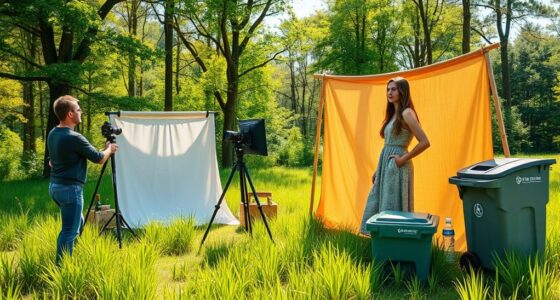To record clean dialogue in noisy locations, you should start by soundproofing your environment with blankets, foam panels, or portable barriers. Position your microphone close to the speaker, ideally with a directional pattern like cardioid, and use accessories like pop filters and windshields. Proper environment setup and microphone placement will markedly reduce background noise. For even better results, explore post-production noise reduction techniques. Keep exploring these methods to guarantee your audio stays clear and professional.
Key Takeaways
- Use portable sound barriers, blankets, or foam panels to create a controlled, quieter environment for recording.
- Position microphones close to the speaker’s mouth and aim directional mics directly at them to minimize ambient noise.
- Select microphones with cardioid or hypercardioid polar patterns to reject side and rear background sounds effectively.
- Incorporate windshields, pop filters, and foam covers to reduce wind noise and plosive sounds during recording.
- Apply noise reduction tools and careful editing in post-production to further clean up dialogue recordings.

Capturing clear dialogue in noisy locations can be challenging, but with the right techniques and equipment, you can considerably improve your audio quality. One of the most effective ways to do this is by focusing on soundproofing techniques and careful microphone placement. Soundproofing doesn’t mean turning a busy street into a recording studio, but it does help reduce unwanted background noise, making it easier to isolate your subject’s voice. Using portable sound barriers, blankets, or foam panels around the recording area can dampen echoes and block external sounds. Even simple measures like positioning your equipment away from windows, vents, or busy walkways can make a noticeable difference. The goal is to create a controlled environment that minimizes ambient noise, so your microphone can focus solely on capturing the dialogue.
When it comes to microphone placement, your approach can dramatically impact the clarity of your recording. Position the microphone as close to the speaker’s mouth as possible without causing discomfort or distortion. This proximity effect boosts the desired voice signal while reducing the pickup of distant sounds. For handheld or lapel microphones, clip them securely near the mouth, pointing directly at it, and avoid any movement that could cause fluctuations in audio quality. If you’re using a shotgun microphone, aim it directly at the subject’s mouth and keep it stable. The key is to find the sweet spot where the microphone captures the voice clearly and minimizes background noise. Experiment with angles and distances to see what yields the best results; sometimes, a slight adjustment can notably improve clarity. Additionally, selecting a microphone with the appropriate polar pattern can greatly enhance noise rejection. Using a pop filter can also prevent plosive sounds from distorting your recordings and improve overall clarity.
Furthermore, consider the environment and the microphone’s polar pattern. Directional microphones, such as cardioid or hypercardioid, are designed to pick up sound primarily from the front, helping to block out unwanted noise from the sides and rear. By aligning the microphone’s focus directly on the speaker, you reduce the amount of ambient noise captured. Using windshields or foam covers can also help filter out wind noise or plosive sounds that might distort the recording. Remember, the key is to be strategic with both your soundproofing techniques and microphone placement. Combining these methods ensures your dialogue remains clear, even amidst a noisy background. Additionally, utilizing noise reduction tools during post-production can further enhance audio clarity. Being mindful of background noise sources during recording can save a lot of time in editing and improve the overall quality of your audio. With practice and attention to detail, you’ll find your recordings become noticeably cleaner, making post-production editing much simpler.
Frequently Asked Questions
What Are the Best Portable Microphones for Noisy Environments?
For noisy environments, you want portable microphones that can handle the chaos. Wireless solutions like handheld mics with strong signal stability give you freedom and reliability. Look for microphones with directional patterns such as supercardioid or hypercardioid—they focus on your voice and reject background noise. These features help you capture clear dialogue, even in challenging settings. Choose the right combination of wireless tech and directional pattern to guarantee top-quality audio.
How Can Post-Production Noise Reduction Improve Dialogue Clarity?
Post-production noise filtering can markedly sharpen dialogue clarity, creating crisp, clean conversations. By applying dialogue enhancement techniques, you reduce background blur and bolster speech, making it more intelligible. These processes target unwanted sounds, trimming the noise and transforming muffled messes into memorable, meaningful dialogue. With careful filtering and enhancement, your audio becomes more immersive, ensuring your audience hears every word, and your message resonates with remarkable resonance.
Are There Specific Techniques for Directing Actors in Noisy Settings?
When directing actors in noisy settings, you should focus on clear voice coaching to guarantee they project well and enunciate. Use acoustic treatment to reduce background noise and help them hear instructions better. Encourage actors to maintain consistent distance from microphones and speak directly into them. These techniques help improve dialogue clarity, even amid challenging environments, making post-production noise reduction easier and more effective.
What Are the Legal Considerations When Recording in Public Spaces?
Remember, honesty is the best policy. When recording in public spaces, you must consider privacy laws and permission requirements. Always get consent from individuals who might be identifiable in your recordings, as laws vary by location. Respect others’ privacy, and avoid capturing private moments without permission. Being transparent and compliant helps you stay legally safe and maintains trust, ensuring your project moves forward smoothly without legal complications.
How Does Weather Impact On-Location Dialogue Recording Strategies?
Weather conditions crucially impact your on-location dialogue recording strategies. You need to take into account how rain, wind, or extreme temperatures can affect audio quality and equipment durability. Windshields and protective covers become essential to reduce noise, while choosing weather-resistant gear helps prevent damage. Planning ahead for weather changes ensures you can adapt quickly, safeguarding your equipment and maintaining clear dialogue recordings despite challenging outdoor conditions.
Conclusion
To successfully record clean dialogue in noisy locations, focus on using the right equipment and techniques, like directional microphones and sound blankets. Imagine you’re filming an outdoor interview during a busy festival; employing these methods can make your dialogue crystal clear despite the chaos around you. With careful planning and the right tools, you can capture professional-quality audio anywhere, ensuring your audience hears every word, no matter how loud the environment gets.









